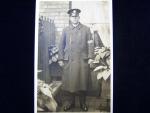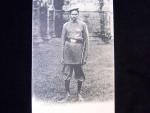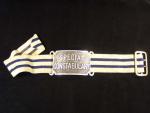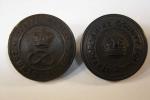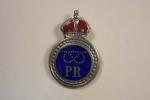-
Posts
6,486 -
Joined
-
Last visited
-
Days Won
10
Content Type
Profiles
Forums
Blogs
Gallery
Events
Store
Everything posted by Brian Wolfe
-
Hello Everyone, Here are some Special Constabulary items from my collection. I'm not sure how long this will take to post so I'll just keep adding to this thread as I go. Please feel free to add your material as well and your comments are, as always, welcomed. The Special Constabulary was founded because so many police officers were signing up for military service in WWI that the authorities needed to fill the ranks. First up is a photo of a Special Constable in "uniform". Please note the armband as I will post a similar item later in this thread. I hope you like this thread and please do add to it. Regards Brian
-
I know it's hard to avoid getting political when it comes to many topics here at the GMIC and I would rather see the content stay with collecting and the research of history. My concern is for the ease of that research. It seems to me it would be a good idea to attempt to keep all posts regarding, say, India, under one title so that one is not forced to search each section for material. If we are putting everything Indian under the police forces of the world then that's good by me. I would just like to see continuity in what we are posting. I just brought up that India, like Canada and others, are indeed members of the Commonwealth of Nations as that seems to be one of the choices. Perhaps I am just being anal in wanting to post my material under the proper heading. Regards Brian
-
Hi Mervyn, I must admit to being a bit confused as to which area some of the items should now be posted. I posted this on the British and Commonwealth Police Forces section as India was under British rule at the time of the photo. I also noticed that some of the older Indian Police medal groups are also in the section for world police services. I am thinking that my Special Constabulary Long Service Medals should be under British and Commonwealth as would any Canadian items I have as Canada is a part of the Commonwealth of Nations. South Africa and India are also members of the 53 nation Commonwealth organization. Are we now going to post ONLY British items under the original thread? If so then I would respectfully suggest the Titles be changed to, "British Police Forces" and "World Police Forces", leaving the term "Commonwealth" out. Personaly I like the "British & COmmonwealth Police Forces" title as we (Canada and South Africa) are part of the Commonwealth of Nations. I hope that is not too political for the forum, as it was not meant to be so. Any direction regarding where to post "Commonwealth" items would be welcomed. Regards Brian
-
Hi Chris, Most serious collectors of Japanese swords keep them in their sheath and display them that way. Musuems tend to display them out of the sheath for the benifit of the public as most people are impressed with the blade but the displays are usually in a climate controled display case. The sheath provides this protection, to a degree. Regards Brian
-
Hello Everyone, Meryvn's Indian Policeman's Uniform post started me searching for this photo that I've had for a while. It is of a Police Officer from Bombay, India. While there is no date on this picture postcard I've seen another that did have the date printed on the front as "c. 1910". The officer wears his number, "188", on his unifrom as well as on the belt buckle except the "188" on the buckle is under the letter "A". Would anyone know what this "A" stands for? Perhaps his detachment, or station house? He is armed with a truncheon, though this one is not as nice as those Mervyn has been posting lately. But I'll bet it would deliver quite the headache all the same. Regards Brian
-

RARE INDIAN POLICE UNIFORM - PRE-1947
Brian Wolfe replied to Mervyn Mitton's topic in Police Forces of the World
Congratulations on the first post of this new section, Mervyn. Great unform. It started me thinking, "Now where did I put that photo...?" I found it but it fits under the other area of this new section so I'll post it there. Regards Brian -
My first thought was that perhaps someone was mucking about trying to create dum-dum bullets. However, this may have been an attempt to make the rounds more suitable for hunting game. That is to say, a bullet that would "mushroom" on impact. I recall there was still a lot of WWI & WWII ammo around when I was a young man and we always felt it was good enough for zeroing in a rifle but we used the more expensive sporting rounds when we hunted. This is just a thought. Regards Brian
-
:jumping: The blade, Ed, the blade. Show us the blade!!!!! What you have already posted makes me salivate. Regards Brian
-

Bayonet help
Brian Wolfe replied to SasaYU's topic in Preservation & Restoration of Military Artifacts
Here's the "problem". This bayonet, if memory serves me, was originally a gun-metal blue. You will never clean this bayonet to look like the original, no matter what you do. The "problem" is that you run a risk of over cleaning. I have seen such items cleaned to the point where it looks like it was polished to a glass finish except it was dark brown. If you clean it to this point then it is only good for supporting tomato plants in the garden. It is totally up to you but I would use a very stiff non-metal brush and scrub off any of the loose rust and dirt and then allow it to dry in the sun or under a heat lamp so that it dries completely and be happy with what you have. Even now it is a great artifact but over cleaning it, say with a steel brush or a steel brush wheel in a hand-held drill, will render it garbage. Now, that's my opinion and as I say it is up to you. Please keep us updated on your decision and the process you finally decide upon. This is how we all learn. Regards Brian -

Bayonet help
Brian Wolfe replied to SasaYU's topic in Preservation & Restoration of Military Artifacts
Hello SasaYU, You have a Russian, Model 1891 it is hard to tell the pattern from the photo but the first pattern was a little smaller than the second pattern. These were made to fit the 7.62 MM M1891 Moisin Ngant Infantry rifle and the 7.62 mm M1891 Moisin Nagant Dragoon rifle. There is no scabbard for these as they were intended to be attached to the rifle at all times. However, some cavalry troops carried it on their sword scabbard by two mounts or a built-in sheath. These were used in both World Wars in great numbers. When found with an all steel scabard it indicates they were captured weapons used by the Germans in WWI. These were also used by Yugoslavia. (reference: Bayonets of the World by Paul Kiesling, volume one, bayonet number 252.) Was this a battlefield find? As to cleaning....I wouldn't do much to it if it were mine. Perhaps other members will have different ideas that they could share. I believe the metal of this bayonet has stabilized and will probably not rust any further. Regards Brian -
Yep, a cut-down, I have a katana that does the same. Still a very nice sword. Somehow I think these have a lot more history associated with them than a blade that was never touched. They were made and then for whatever reason reworked into a shorter sword. I think the chances a reworked blade saw action is greater than a pristeen blade. Regards Brian
-
Hi Ed, This mon of 3 oak leaves (kashi) is shared by the Makino, Horimoto and Kasai families among others. [reference: Military Swords of Japan 1868-1945 by Richard Fuller and Ron Gregory, pg.96] You say that this might have been cut down. Does the temper line run along the blade and up the tip to the back edge of the blade or does it run along the blade and out "through" the tip's edge? If it runs out the tip and not along it then this means it has been shortened at one time. Cut down swords are not uncommon. It was a way to reuse damaged swords and to extend the usefulness of the longer blades when they fell out of accepted tactics on the battlefield. I like your sword very much, thanks for posting it. Regards Brian
-
Hello Everyone, Here are two more buttons from my Staffordshire Police collection. They are both made of a dark material that could be plastic or perhaps Bakelite. The one on the right has the King's crown and could be King Geo V or KIng Geo. VI, depending on the age of the buttons. There is noting on the back og the button except for a circle that runs 3.5 mm from the edge. There is a metal loop for attachment and it measures 25.5 mm in diameter. The button on the left has the Queen`s crown the measurements and composition being the same as the one above. On the back is marked, J.A.GROVE & SONS HALESOWEN. I think this is the crown of Queen Elizabeth II but the button looks much older than the King`s crown example. I researched L.A. Grove and Son and found that the company was founded in 1857. I would like to think this is Victorian due to its look of antiquity but the crown looks like the Queen Elizabeth II version. My intention is to eventually post my collection on the Collector`s Gallery and I would like to be accurate so any help you can extend to me would be appresiated. Regards Brian
-
Hello Everyone, Here are three metals buttons from my collection of Staffordshire Police Service memorabilia. From left to right they are: Victorian period, Staffordshire Constabulary, measuring 23.5 mm in diameter. The front is marked STAFFORDSHIRE CONSTABULARY. The back is marked REYNOLDS & CO. LONDON. The button has a medal loop on the back for attachment. King's crown, probably Geo. VI but it could be Geo. V., from what I can tell there was no change to the buttons as the same crown was used for both monarchs. The front is marked, STAFFORDSHIRE COUNTY POLICE. It measures 24.5 mm in diameter, with only a decorative border on the back. A metal loop was used for attachment. Note the absence of the Staffordshire Knot. Queen's crown of Queen Elizabeth II, measuring 24.5 mm in diameter. The back with its familiar metal loop is marked with the same decorative border as the King's crown issue. The front is marked, STAFFORDSHIRE COUNTY POLICE. Later buttons had only the Queen's crown with no lettering. Regards Brian
-
To me it looks like a ceremonial piece, something that would be worn or carried on parade or during sepcial events to indicate a rank or position. I don't believe it is North American First Nations in origin, not only due to the age of the photograph but the handle end-cap looks too decorative for N.A. Native. It is also not made rugged enough for a fire axe in my opinion. It's more decorative than utilitarian. Thanks for posting this interesting photo Robert. I look forward to hearing what others think. Regards Brian
-
Hello Everyone, This is an example of a lapel pin worn by the Staffordshire Police Reserve. The Special Constabulary and the Auxiliary Police also had similar pins. This pin with its blue and red enamelling and King's crown measures 19.5 mm wide and 29.5 mm in height. The attachment lug is missing on this specimen , the maker's name on the back reads "J.R.GRANT, LONDON". Regards Brian



